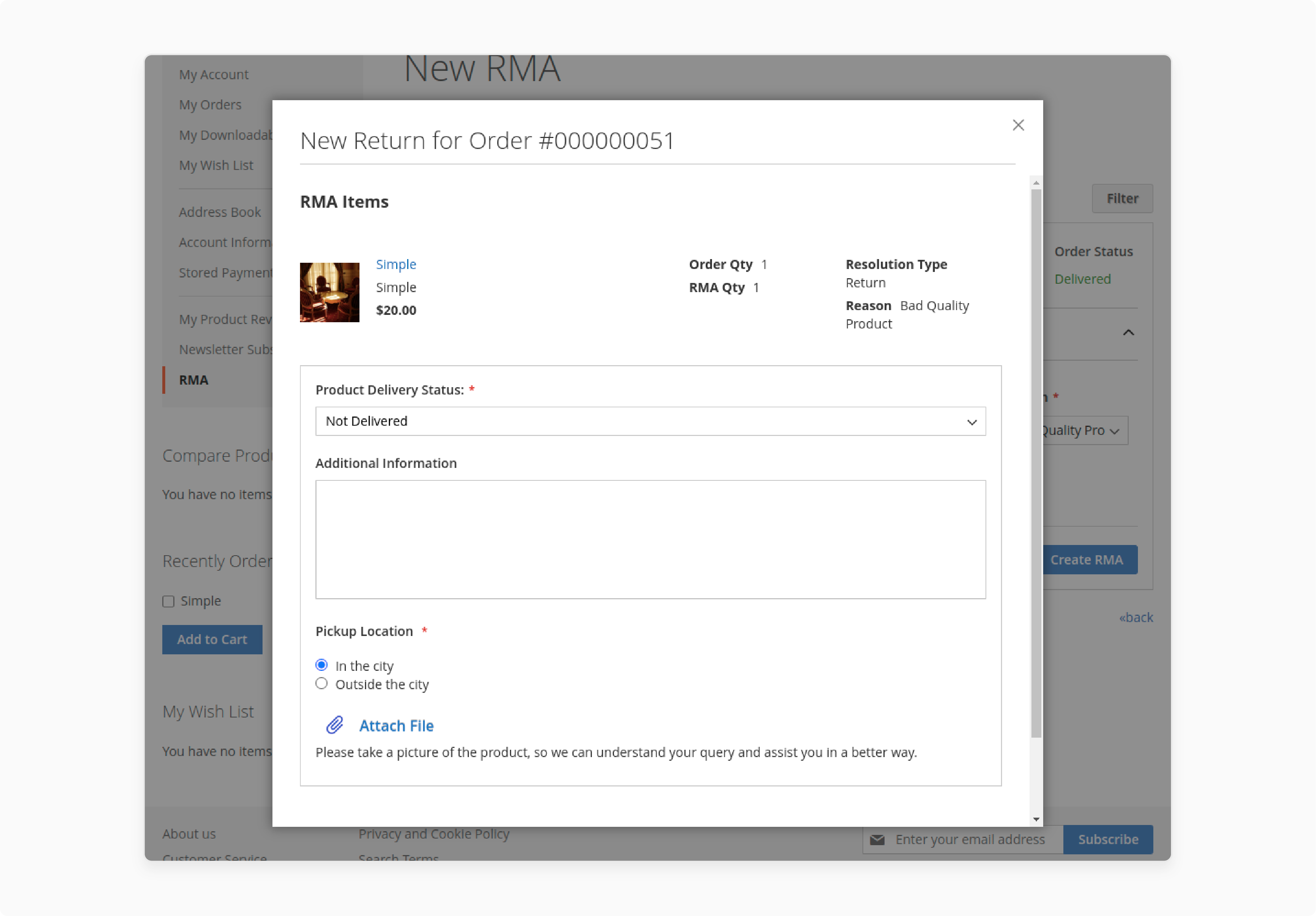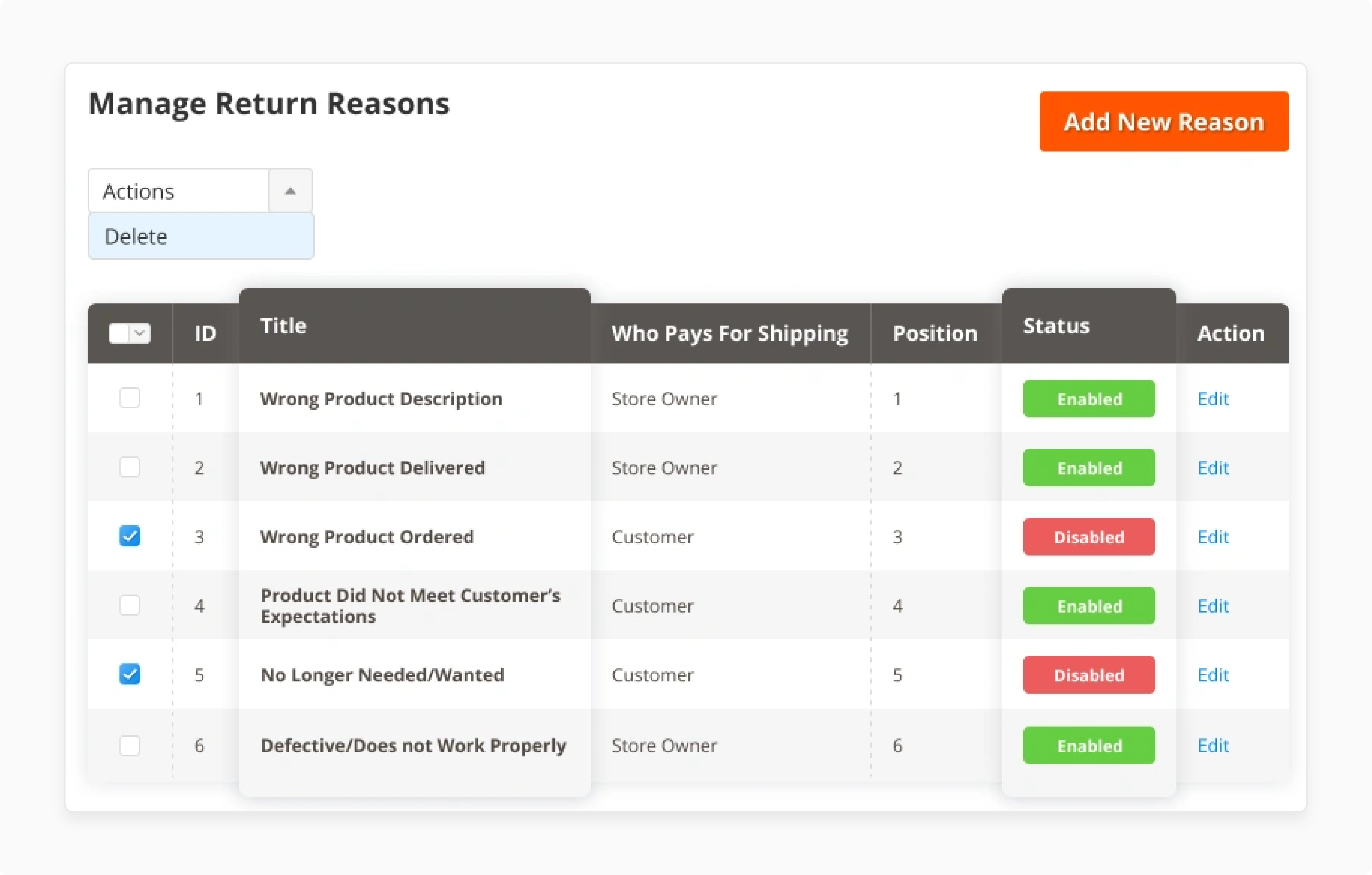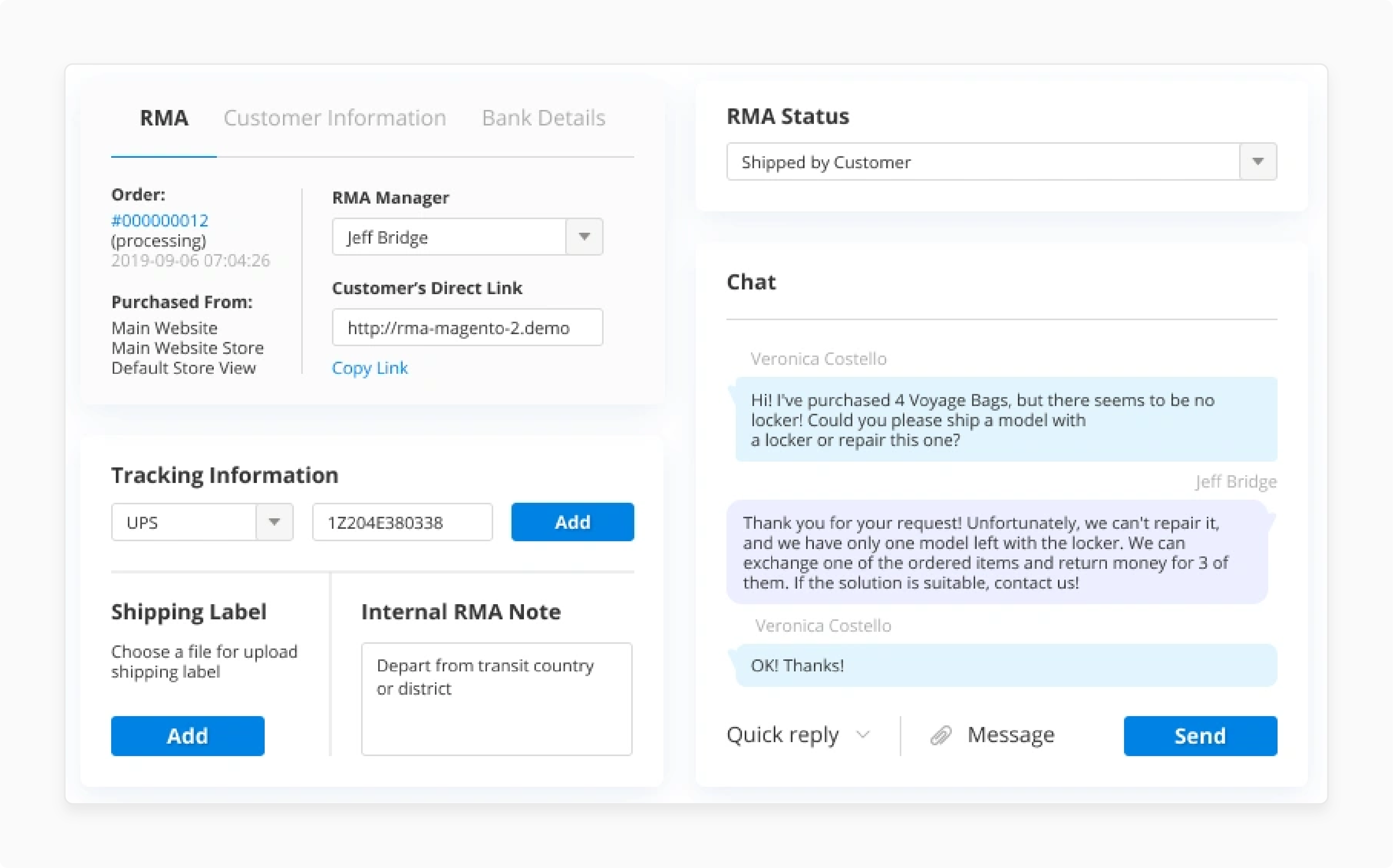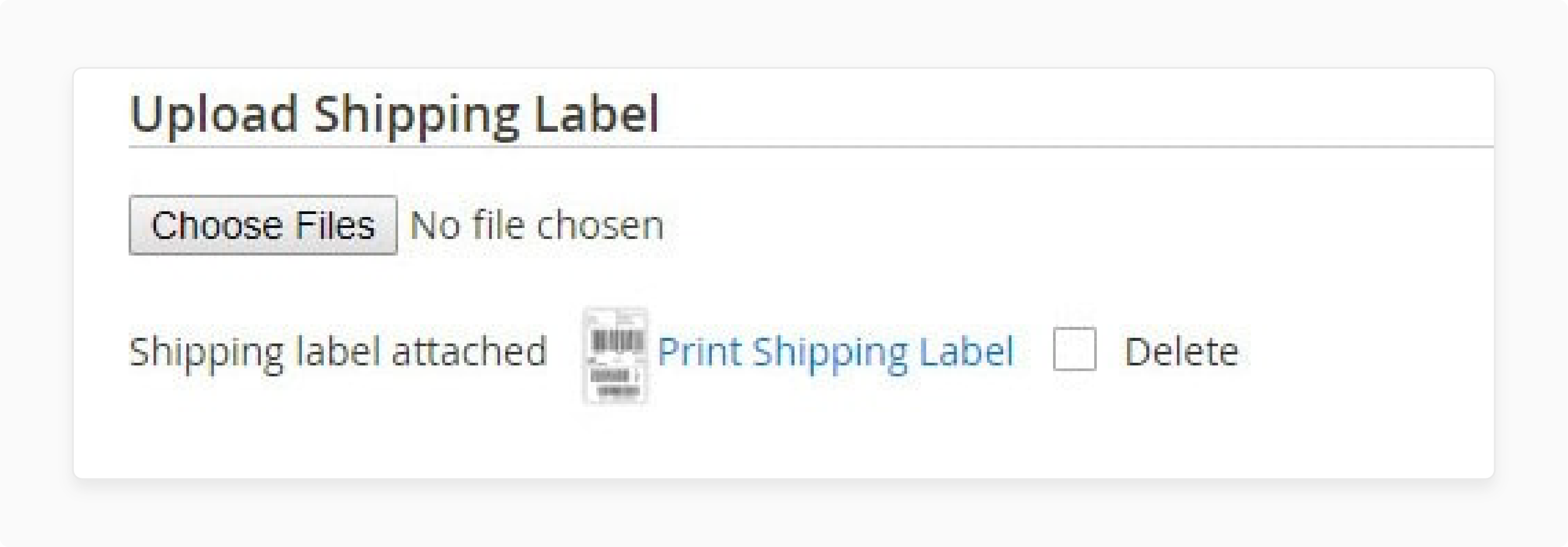
Magento 2 Return Order Extension: Key Features and Use Cases
Ready to automate and manage your return requests effortlessly? Magento 2 return order extension helps simplify the return process for your online store.
In this article, we will explore the features and use cases of Magento 2 return order extension.
Key Takeaways
-
RMA extension simplifies product returns and exchanges for stores.
-
Real-world brands use the extension effectively.
-
Magento 2 return order extension differs from top alternatives.
-
Boost customer satisfaction with a smooth return process.
-
Make informed choices about managing returns in your Magento store.
-
Comparing Magento 2 Return Order Extension with Alternatives
-
Common Causes and Solutions of Magento 2 Return Order Extension
What is the Magento 2 Return Order Extension?
The Magento 2 return order extension simplifies managing product return and exchange for eCommerce stores.
Customers can easily submit RMA requests from their accounts. The return extension for Magento 2 simplifies the return process. The Magento 2 extension offers:
-
Customizable return policies
-
Real-time tracking for customers
-
Intuitive admin interface for store owners
Magento 2 RMA extension also enables direct communication between customers and support teams. It ensures smooth updates on return statuses.
The Magento 2 RMA module boosts customer satisfaction while reducing the hassle of managing returns. It helps stores with frequent return or exchange needs.
Features of Magento 2 Return Order Extension
1. Effortless Return Process

-
Customers can easily submit return requests (RMA) directly from their accounts. There is no need for complicated forms or manual intervention.
-
They can:
1. Select specific return items
2. Provide reasons
3. Upload supporting documents
-
These include images of damaged goods to expedite the process.
2. Customizable Return Policies

-
Businesses can define unique return policies that align with their operational needs. It includes:
1. Setting eligibility rules for specific product categories
2. Setting timeframes for returns
3. Offering exchanges for certain items
-
For instance, clothing stores can set a 30-day return period. Electronics may have stricter rules.
3. Predefined and Custom Return Reasons
-
The extension provides a list of predefined return reasons, such as:
1. “Defective Item”
2. “Wrong Product Sent”
3. “Change of Mind”
-
Customers can input custom reasons if the predefined options don’t fit. It helps ensure complete clarity.
4. Real-Time Return Tracking
-
Customers are informed at every step of the return process. Customers can view the real-time RMA status of their return in their account processes, including:
1. Request submission
2. Approval
3. Shipment
4. Refund completion
-
It helps reduce the need for additional inquiries.
5. Advanced Admin Management

-
Admins have complete control over the return process via the admin panel.
-
They can view all submitted return requests and manage the return for approval or rejection.
-
They can also assign return statuses and issue refunds or exchanges as needed.
6. Flexible Refund Management
-
Admins can process full or partial refunds based on the return request.
-
If a customer returns only part of their order, the admin can calculate and process the refund proportionately.
7. Automated Workflow Handling
-
Automation minimizes manual intervention by handling repetitive tasks like:
2. Return status updates
3. Automatic approvals
-
It is based on predefined rules. It reduces errors and speeds up processing.
8. Return Label Generation

-
Businesses can provide pre-paid shipping labels or allow customers to generate their own. It helps simplify the return shipment process.
-
It is particularly useful for stores that offer free returns. It helps ensure a smooth experience for the customer.
Real-World Use Cases of Magento 2 Return Order Extension
| Use Cases | Explanation |
|---|---|
| 1. ASOS | ASOS offers hassle-free returns for customers. These receive the wrong size or are unhappy with their purchase. The extension allows customers to initiate a return. They can also specify a reason, like "incorrect size," and request an exchange. Customers can track their requests and replacements through their account dashboard. It helps reduce the burden on customer support. |
| 2. Party City | Party City sees a spike in returns after major holidays for items like costumes or decorations. The extension can help automate and simplify these seasonal returns. It is by categorizing products and processing returns quickly. Customers can select reasons like “Unused – Returning Post-Season” to expedite processing. |
| 3. Uline | Uline supplies bulk packaging materials. They use the extension to process returns for businesses. If a company orders incorrect sizes or types of packaging materials, they can initiate a partial return. It is done through the portal while keeping some items. It helps ensure minimal business disruption. |
| 4. Home Depot | Home Depot can simplify the return process for large appliances like refrigerators. A customer can initiate a return for a damaged item. The admin can generate a return label or arrange a pickup through integrated return shipping label options. |
| 5. Warby Parker | Warby Parker allows customers to try eyewear at home before buying. The extension helps customers return unsuitable glasses. It is by selecting the reason and receiving a shipping label. They can also track their return status until a replacement is issued. |
| 6. Scholastic | Scholastic is a supplier of books and educational materials. They can manage returns for damaged or duplicate items. A school can submit a return request for a box of damaged books and receive a replacement promptly. It ensures minimal disruption to classes. |
| 7. AutoZone | AutoZone can simplify returns for incorrect or incompatible parts. A customer purchasing a car battery for the wrong model can initiate a return. They can attach a photo of the product and request the correct replacement through the portal. |
Comparing Magento 2 Return Order Extension with Alternatives
| Feature | Magento 2 Return Order Extension | Returns Manager by Amasty | RMA by AheadWorks | Returnly (Standalone Solution) |
|---|---|---|---|---|
| 1. Ease of Integration | It is built specifically for Magento 2. It offers a smooth setup. | It is compatible with Magento. It offers quick and smooth integration. | It is a native Magento extension. It is designed for Magento. It offers easy installation. | It requires API-based integration for multiple platforms. It is less Magento-specific. |
| 2. Custom Return Policies | It is fully customizable for products, categories, and customer groups. | It offers advanced settings for return rules and policy customization. | It offers flexible customization for product-specific policies and store rules. | It offers basic policy settings. It is less focused on product-specific customization. |
| 3. Return Workflow Automation | It automates approvals, notifications, and updates. | It automates approvals with rule-based workflows. | It provides conditional workflows for approvals. | It offers a high level of automation. It is especially for refunds. |
| 4. Customer Communication | It offers a built-in messaging system. It is for direct communication between customers and admins. | It supports two-way messaging between customers and admins within the platform. | It offers limited messaging tools. It relies on email-based support. | It primarily emphasizes email notifications. There is no direct messaging system. |
| 5. Real-Time Tracking | Customers can track their return status. It is done via their account dashboard. | It offers comprehensive tracking for customers and admins. It is done within the Magento Backend. | It offers basic tracking capabilities for customers to track their return progress. | It offers advanced tracking integrated with logistics. |
| 6. Predefined Return Reasons | It offers extensive predefined reasons with a custom input option. | It offers a dropdown selector with multiple predefined return reasons. | They come with a standard predefined reason. It offers minimal customization. | It offers limited customization for predefined reasons. It comes with a rigid structure. |
| 7. Return Label Support | It allows admins to generate and share return labels. | It supports generating and attaching pre-paid labels within Magento. | It offers manual label creation or third-party integration. | It offers strong carrier-based label generation and sharing through carriers. |
| 8. Refund Options | It supports both partial and full refunds. It is based on admin settings. | It offers flexible refund and store credit options. These are managed in the admin panel. | It supports refunds, store credits, or replacements. | It focuses on automatic refunds via logistics. |
| 9. Multi-Currency and Multi-Store Support | It is compatible with global stores. It supports multiple currencies. | It offers multi-store setups and multi-currency support. | It is designed for international stores. It comes with a very few limitations. | It requires additional configuration for multi-currency use. |
| 10. Pricing | It incurs a one-time cost with no recurring fee. It is affordable for small to large stores. | It incurs a one-time cost with no recurring fee. There is a slightly higher upfront cost. | It incurs moderate pricing. It offers competitive features for Magento stores. | It incurs subscription-based, higher ongoing costs. |
| 11. Best Use Case | Magento-specific stores that handle frequent returns. They need customization and automation. | Stores that need advanced approval settings and granular control over return settings. | Small to medium Magento stores that require straightforward return management and basic needs. | Multi-platform eCommerce businesses focused on automation and logistics. |
Common Causes and Solutions of Magento 2 Return Order Extension
1. Configuration Issues
Incorrect or incomplete settings in the extension’s configuration. It may include features being turned off or misaligned with your store policies.
Solution:
-
Navigate to RMA in the Magento Admin panel. Ensure that the extension is enabled and all settings align with your store's return policy.
-
Test configurations by placing a test return request to validate the setup.
2. Outdated Extension Version
Using an older version of the extension can lead to:
1. Bugs
2. Compatibility issues
3. Missing features
Solution:
-
Always update the extension to the latest version provided by the developer.
-
Before updating, create a full backup of your website and database. It helps avoid downtime in case of failures.
-
Review the release notes of the update for any new features or important changes.
3. Theme Incompatibility
Custom themes often have modified layouts or styles that may conflict with the extension’s functionality.
Solution:
-
Temporarily switch to Magento’s default theme to check if the issue persists.
-
If the extension works with the default theme, collaborate with your theme developer. It helps ensure compatibility.
-
Avoid hardcoding; use Magento's customization best practices for theme adjustments.
4. Extension Conflicts
Conflicts between multiple extensions, particularly those related to order management or customers' order IDs, can lead to unexpected errors.
Solution:
-
Use Magento's built-in tools like the Developer Mode and error logs to identify conflicts.
-
Disable recently installed extensions one by one to isolate the issue.
-
Contact the conflicting extension’s support team or hire a Magento developer. It helps resolve code-level conflicts.
5. Server-Side Issues
Limited server resources or incorrect PHP settings can prevent the extension from functioning optimally.
Solution:
-
Increase the PHP memory limit, execution time, and upload limits in the server configuration.
-
Choose a Magento-optimized hosting provider. It offers better scalability and performance for handling extensions.
6. Missing RMA Workflow Setup
Without a proper RMA workflow, the system cannot process return requests.
Solution:
-
Set up RMA workflows. Define return statuses, reasons, and email templates for each stage of the RMA process.
-
Test the workflow to ensure smooth communication between customers and administrators.
7. Database Errors
Corrupt or missing database entries related to the extension can lead to functionality issues.
Solution:
-
Run Magento CLI commands to refresh the database and indexes. Clear the Magento cache.
-
If the issue persists, use a database repair tool or consult a database specialist.
8. Poorly Designed User Interface
A complicated or confusing user interface can discourage customers from completing return requests.
Solution:
-
Optimize the RMA form to make it user-friendly and intuitive.
-
Use clear labels or dropdown menus for return reasons. Provide a progress tracker for the return process.
-
Gather customer feedback to improve the design further.
FAQs
1. How do customers create an RMA request in Magento 2?
Customers can create RMA requests for purchased products directly from their accounts. The Magento 2 RMA extension allows users to select items, provide reasons, and upload supporting documents. It simplifies the return experience and reduces customer support inquiries.
2. What are the key features of the Magento 2 returns extension?
The Magento 2 returns extension supports customizable return policies and refund status updates. It allows admins to manage the return request efficiently. It also helps them offer customers pre-paid shipment labels. These features simplify the return management process for stores.
3. Can the Magento 2 RMA extension handle different return scenarios?
The Magento 2 RMA extension covers various return scenarios. These include partial refunds or exchanges. Customers can send the product back with pre-defined or custom return reasons. The extension ensures a smooth return management process for both stores and customers.
4. Is the Magento 2 new RMA system suitable for guest users?
The RMA for Magento 2 allows guest users to submit return requests. With the Magento 2 RMA shipment label feature, they can return the product smoothly. The functionality enhances the return experience for all types of customers.
Summary
The Magento 2 return order extension simplifies product return and exchange processes for eCommerce stores. The article explores the key features of the extension, including:
-
Customers can easily submit RMA requests with tracking and document uploads.
-
Businesses can define custom return policies for categories and timeframes.
-
Real-time tracking and automated workflows reduce manual tasks and errors.
-
Admins manage returns, refunds, and labels through an intuitive interface.
Enhance your store's efficiency with the Magento 2 return order extension. Pair it with managed Magento hosting for superior customer satisfaction.




